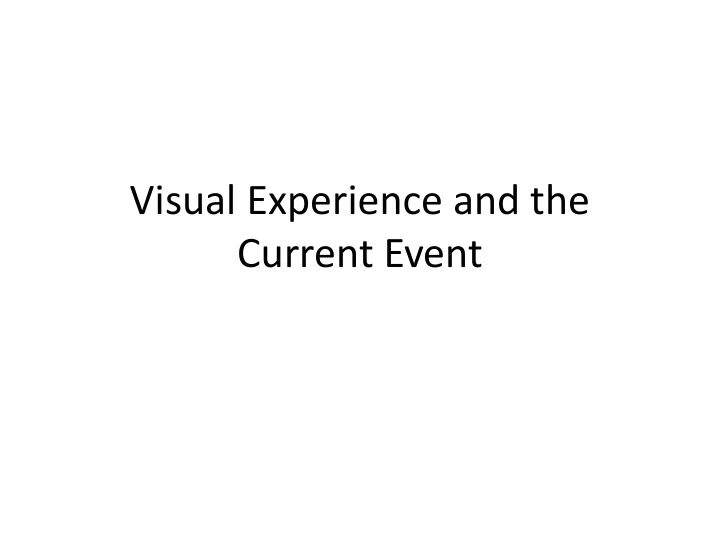

Visual Experience and the Current Event
The Interpretation of Motion • Event perception embeds constraints on motion from how object move in the world – Gravity and evolution & experience builds expectation on sort of movement to occur • People ‘fill in’ missing information when observer misses part of motion path - Apparent motion: Is a consequence of ‘filling in’ motion based on expectation • Generates strong motion percept: the strength of which depends on: Distance between the objects; Percept intensity; The duration of the interval between the first object’s offset and second object’s onset
Apparent motion Display • • Path-guided display – perceive Simple Apparent Display - apparent motion as following a one visual element offsets path, geometrically simple and another onsets (a) Simple Apparent display (b) Path-guided Apparent display ( c) Ambiguous Apparent display • Display is ambiguous; the square in the left perceived as moving to the bottom left or to the top right Figure 5.4 Apparent Motion display, arrow denotes a brief delay
What affects Apparent motion? • Affected by: Physics, Recent history and how things move • Biological motion constrains the path an apparently moving body takes. • Spatiotemporal forms: determined by underlying dynamics of the system that produced the motion • Viewers Expectation: Hardwired by evolution and/or Learned over experience
Apparent Motion • It is an optical illusion in which stationary objects viewed in quick succession appear to be in motion; An example of interpolation based expectation • Representational Momentum – systematic error in visual working memory {extrapolated motion and distortion} • Representational momentum and related memory distortion occur because as we observe an event we simulate aspects beyond what’s seen
Biological Motion Perception • Biological Motion – movement of person or other living organism • Point-light walker stimulus - biological motion made by placing lights in specific places on a person • Structure-from-motion takes place with point- light walkers • Neurological studies show biological motion is processed in the superior temporal sulcus (STS)
Biological Motion Demo • Mood is systematically related to body motion pattern. • All these cues allow a perceiver to bootstrap from peripheral sensory features to conceptually meaningful aspects of an event. • Humans were discriminated from other animals; gender and age; weight, arousal state, and mood were animated and distinguished
Biological Motion Demo • Biological Motion
Biological Motion Perception • Is associated with Neural processing • One region in the lateral Occipitotemporal cortex (extrastriate body area) responds selectively to visual depictions of bodies • Lateral Superior temporal sulcus responds selectively to point-light biological motion displays
Biological Motion - Summary • The perceptual system settles on smooth forms that are as simple as possible consistent with the sensory information. In synch with the Gestalt principles of visual grouping. • It does not depend on previous experience. However, the identification of individuals from motion would seem to require experience.
Causes, Intension and Social Behaviour • Motion provides clues on intentions: What a person intends to do {movement to} and when an intentional action has ended {retract} • Movement conveys information about goals, intensions and personalities of actors • Viewers can construct rich representations of events consisting of intentional social actions from patterns of movement alone.
Causes, Intension and Social Behaviour • Viewers key in on features of movement that discriminate intentional animate motions from mechanical movements - wolf & sheep • Viewers can make fine and accurate discriminations from motion alone • If biological motion processing and the attribution of intentions are coupled, it produces traces in the patterns of neural activity when people view other’s actions
Causes, Intension and Social Behaviour • Activation in STSp can be obtained without biological movement patterns. – Neurons representing intentional actions that keep firing – Woman’s intention incongruent with her action, the right STSp responds more • The right region of STPp selectively activated by features of human action that are specific to biological motion /or intentional action
Causes, Intension and Social Behaviour • Possibility of activations: (a) The STSp “really” is selective for processing intentions (b) Responses to biological motion cues and to animacy are co-localized because they are tightly coupled computationally (c) Regions responsive to biological motion and to intentional action may be different units that happen to be nearby the cortex • People use a set of expectations beyond those that apply to movements of inanimate objects
Vision and Language, Vision and Action • Perception is tightly coupled to language understanding, action, planning and problem solving. May apply for perception of events • Visual information can be used to update the location of objects, integrate with linguistic input and world knowledge for identification and disambiguation {“this” identification} • Visual information is combined with linguistic information to construct event representation – Boy sitting with cake, ball, truck, train; when speak eyes move to object
Vision and Language, Vision and Action • Conclusion: Listeners integrate information about possible objects, the action could apply to with their representation of the situation depicted by the picture, they do so rapidly • Visual and Linguistic information is combined to form event representation • Event representations are not just for passive comprehension and offline thinking, but also guiding action online
Chapter Summary • Visual motion plays role in event perception • Features related to entities, causes and goals can be experienced visually; • Media as movies and comics, introduce visual features that do not occur in nature, and how they affect even perception – give insights into how events are perceived and conceived • Visual perception of events interacts pervasively with our actions and intentions for actions
Recommend
More recommend